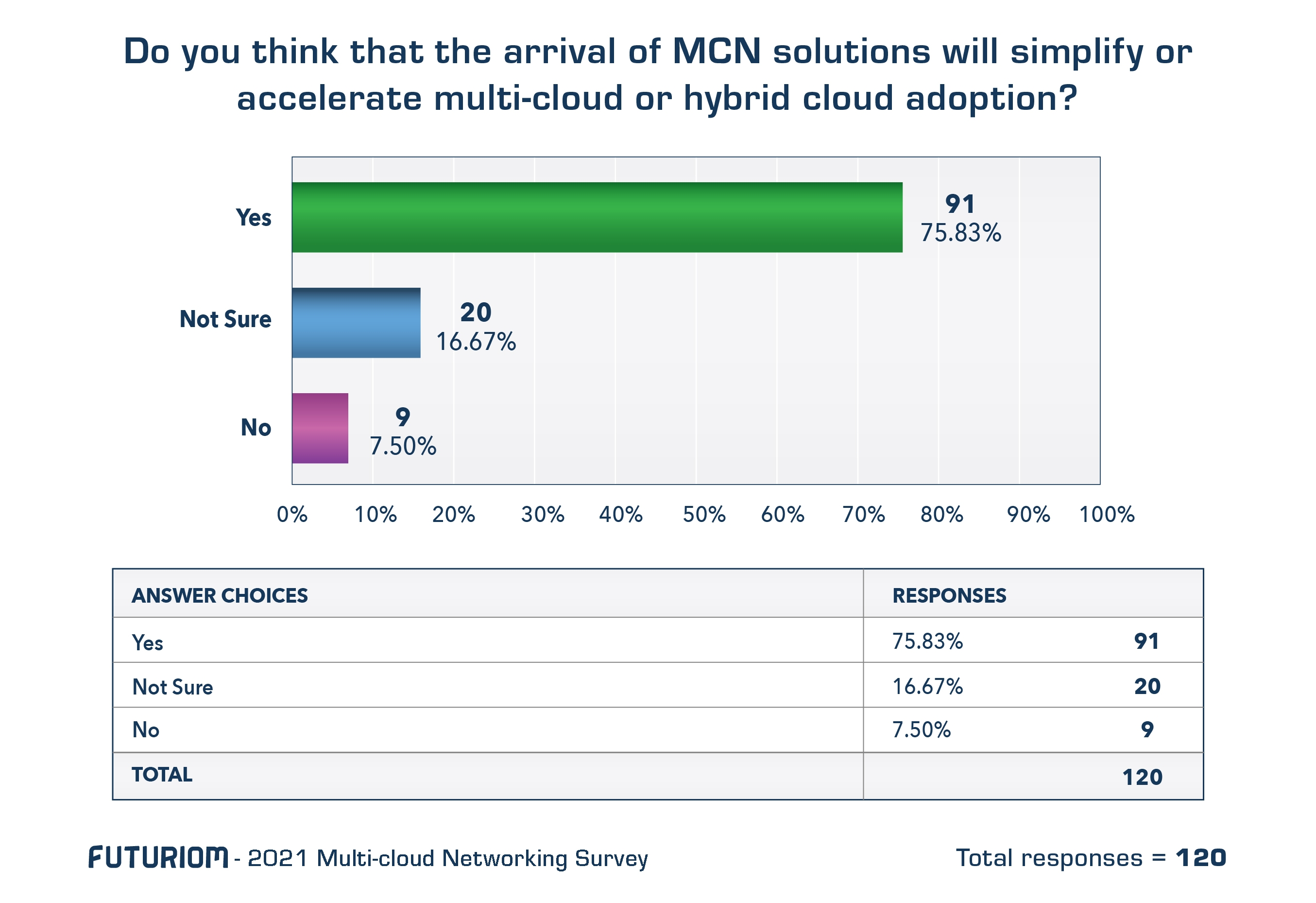Third Wave of Networks: Multi-Cloud Networking Market Growth Drivers

As public cloud infrastructure expands to provide trillions of dollars of resources and services to enterprise end users, organizations have become more confident in moving large portions of their IT infrastructure to the cloud, which has become a more complex environment for distributed applications that can run in private clouds, public clouds, and hybrid clouds.
While it’s clear that organizations are moving to adopt a multi-cloud and hybrid cloud approach, they have many technology obstacles. One of their major needs is a new type of networking infrastructure – software-driven multi-cloud networking (MCN) – which can be used to dynamically provision, manage, and control connectivity among enterprise networks, private data centers, and public clouds. With organizations and enterprises starting to use multiple cloud resources, including both public clouds and private clouds, they need better ways to connect these resources using a software-defined approach.
The Third Wave of the Cloud
MCN is an important new development in the virtualization and abstraction of networking resources. The power of abstraction, which separates software and hardware functions into components that can be managed by more dynamic software control, is what has powered the cloud. Abstraction has enabled the virtualization of server hardware, storage hardware, and networking hardware.
MCN represents the Third Wave of Cloud Networks, a trend driven by network virtualization across and among clouds. Network virtualization was spawned in the early days of private cloud and data-center networks as a way to support massive scale. Innovation developed by cloud providers such as Amazon and Google enabled their networking software functionality to be develop separately from hardware, in a movement known as software-defined networking (SDN). This enabled clouds to scale by quickly adding racks of compute and networking hardware that could be managed by software.
This first wave of networking virtualization and SDN fueled large-scale data center networking, a market dominated by the likes of Cisco Systems and Arista Networks (widely regarded as #1 and #2 in the market, respectively), who sold more scalable systems for both private and public cloud.
The next wave of networking virtualization came at the enterprise branch, where SD-WAN was adopted to enable better software control for WAN access as well as automating deployment of WAN branches using software. The SD-WAN view is branch-centric – it helps branches get to the cloud faster, but it is not concerned with what’s happening inside the cloud.
The third wave of cloud networks and virtualization innovation is MCN. Multi-cloud networking is needed because while data-center virtualization and SD-WAN are useful technology innovations, they address specific areas: data centers, public cloud data centers, and branches. They don’t address connectivity both across and inside multiple clouds. Think of MCN as building a global abstracted network that can now connect all of these resources, including simultaneously connecting networks both inside and outside of clouds. Futuriom believes this next wave could be even bigger than the prior two, given the scale of public cloud.
Download this report now to get the full results!

Survey Methodology and Audience
To guide our research and investigation into MCN, we have conducted a new survey, as a follow-up to our inaugural MCN report in 2020. Our research is also based on months of interviews with end users, and discussions with technology vendors.
The MCN Survey was conducted to get a view into the needs and challenges of MCN from the end users. The survey questions were developed collaboratively by Futuriom analysts in consultation with industry experts in networking. The survey was open during September 2021 and completed at the end of the month.
End users were surveyed using a publicly available cloud-based survey tool. We targeted two audiences with the survey: 1) The Futuriom end-user database; and 2) A public audience targeted according to the following rules:
- Employed full-time
- Job Function in IT
- Director-level or above (including Executive, C-Level, Senior Management, Middle Management)
- Minimum number of employees in company: 500+
Our own database was supplemented with additional responses obtained through targeted advertising to insure a balanced audience. All respondents were qualified by a filter question asking if they were involved in an IT role in DevOps, IT, cloud planning, or networking. We tossed out anybody not involved in those roles. A total of 120 end users filled out the whole survey, though we have also included partial survey responses. We have marked the response rate of each question. All of the respondents are based in the United States. (Although we would like to collect more international data, that is becoming more difficult over time due to privacy regulations.)
Highlights and Key Findings
Here are some of the key findings of our survey research:
• Multi-cloud networking (MCN) represents the Third Wave of Cloud Networks – adding to data-center virtualization (Wave 1) and software-defined wide-area networking (SD-WAN — Wave 2) to support and integrate multi-cloud and hybrid cloud operations. Futuriom expects this to be the largest wave of investment in cloud networking to date. The market should eventually climb to tens of billions of dollars.
• Our 2021 MCN survey and research indicate that demand for MCN technology is expected to grow quickly. Of those surveyed, 83% are considering MCN solutions to better manage connectivity among public clouds and private networks.
• End users and IT staff are starting investments in MCN, which they expect to improve cloud operations and security. Of those surveyed, 87% expect that MCN will help improve overall security, visibility, and governance. A full 71% of those surveyed expect to invest modestly or substantially in MCN technology.
• Information technology (IT) professionals and CxOs require cloud networking innovation to enable multi-cloud and hybrid operations that will drive digital transformation efforts. Of those surveyed, 83% said they were examining MCN solutions to help manage and integrate connectivity among public cloud and private networks.
• MCN use cases and drivers are widespread. Key capabilities cited by users include improved governance; multi-cloud network analytics and applications visibility across multi- and hybrid cloud; automated provisioning of cloud networks; multi-cloud application performance; data-center bypass; and multi-cloud application prioritization.
Companies highlighted in this report: Alkira, Arrcus, AT&T (T), Aviatrix, Amazon (AMZN), Aryaka Networks, Cato Networks, Cisco (CSCO), Citrix (CTXS), Digital Realty (DLR), DriveNets, Equinix (EQIX), F5 Networks (FFIV), Fortinet (FTNT), Google (Alphabet - GOOGL), IBM (IBM), Itential, Juniper Networks (JNPR), Megaport, Microsoft (MSFT), NetFoundry, Nokia (NOK), PacketFabric, Prosimo, Tata Communications, Verizon (VZ), VMware (VMW)
Download this report now to get the full results!




